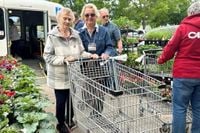At the Odell McCallum Community Center in Wynne, Arkansas, a line is expected to form early on October 9, 2025. The Food Bank of Northeast Arkansas is hosting its monthly drive-thru USDA food distribution for residents of Cross County, hoping to meet growing demand in the region. This event, running from 9 to 11 a.m. or until supplies are depleted, is just one example of how local communities are mobilizing to address a deepening hunger crisis across America.
According to NPR, nearly 47 million Americans now face food insecurity, a number that has surged as federal food assistance programs have been cut. The impact is felt in food pantries nationwide, where the shelves are increasingly busy and the lines longer. But behind the scenes, another challenge looms: the backbone of these operations—volunteers—are themselves aging, and new recruits are hard to come by.
Take the case of Phylis Allen, age 78, who has spent the past 17 years helping to run a food pantry in Winterport, Maine. As reported by NPR, Allen’s weekly routine includes scouring local stores for affordable groceries, like eggs at $2.82 a dozen, and ensuring the pantry doors open to a waiting crowd every Wednesday morning. She’s not alone; her colleagues range in age from their late sixties to nearly ninety. "I'm not the oldest," Allen quipped, highlighting that some volunteers are 88 or 89 years old.
This reliance on older volunteers is not unique to Maine. According to AARP data cited by Florida Today, retirees aged 65 and older account for 28.6% of all volunteer hours in America. These seniors bring a wealth of experience, dedication, and compassion to their roles, often serving as inventory managers, administrators, and even cheerleaders for their communities. However, as the average age of volunteers creeps upward—Hannah Chatalbash, executive director of the Mid Coast Hunger Prevention Program in Brunswick, Maine, estimates their volunteers average about 75 years old—the sector faces a looming risk. "We consider this, like, impending cliff of these current volunteers, who've been very dedicated for the last decade, aging out. We label that as a risk factor for our organization, absolutely," Chatalbash told NPR.
The challenge is compounded by declining volunteerism among younger generations. As demand for food assistance increases, thanks in part to cuts in the Supplemental Nutrition Assistance Program (SNAP), the pool of available helpers is shrinking. Food pantries, which distributed over 650,000 meals in Brunswick alone last year, are feeling the pressure. Losing even a single volunteer can cripple a small operation. As Allen humorously put it, she was on the lookout for "a hunk with a truck" to help with weekly food pickups—a role eventually filled by a 67-year-old driver, but hardly a long-term solution.
Despite these hurdles, the spirit of volunteerism remains strong, particularly among seniors. Volunteering offers them more than just a way to give back. As Brenda Lyle, a certified care manager at One Senior Place in Greater Orlando, explained in Florida Today, "Volunteering provides seniors with a sense of purpose, community connection, and personal growth." Studies suggest that such engagement improves mental, physical, and cognitive health for retirees, and can even lead to longer, healthier lives. The benefits are mutual: communities gain from the wisdom and skills of older adults, while volunteers themselves find fulfillment, new friendships, and a sense of accomplishment.
Opportunities for seniors to get involved are abundant and varied. They can mentor children at after-school programs, assist at local schools, work with animal shelters, or lend a hand at museums and libraries. Food banks and soup kitchens are especially reliant on their help. For those in Central Florida, Volunteers for Community Impact connects seniors with roles in Orange, Volusia, Osceola, and Seminole counties. On October 13, 2025, One Senior Place in Viera will host a Senior Job and Volunteer Fair to link eager retirees with organizations in need of their talents.
Back in Arkansas, the Food Bank of Northeast Arkansas is doing its part to make food assistance accessible and equitable. Households in Cross County can receive USDA foods once per month, provided they meet income guidelines set for The Emergency Food Assistance Program (TEFAP). Eligibility is determined through self-declaration of name, address, family size, and combined monthly income. Food is distributed on a first-come, first-served basis, and recipients can pick up food for themselves or, with proper authorization, for shut-in or elderly neighbors. Case workers collecting for larger groups are asked to coordinate with the food bank in advance.
The Food Bank of Northeast Arkansas and the U.S. Department of Agriculture take civil rights seriously, explicitly prohibiting discrimination based on race, color, national origin, sex (including gender identity and sexual orientation), disability, age, or reprisal for prior civil rights activity. Recognizing the diversity of those they serve, staff and volunteers use translation apps to assist individuals with limited English proficiency. For questions about eligibility or the distribution process, residents are encouraged to contact Natalie Neal at the Food Bank of Northeast Arkansas.
Yet, even as these systems strive for inclusivity and efficiency, the underlying strain is clear. The country’s emergency food network is at a crossroads. With the number of food-insecure Americans on the rise and the volunteer workforce aging, the need for new, younger volunteers has never been more urgent. As NPR’s Elaine Appleton Grant observed, "Volunteerism has declined dramatically over the last 20 years. Plus, demand for food assistance is growing. Things will get worse with cuts to the federal Supplemental Nutrition Assistance Program, or SNAP."
For now, the system persists thanks to the dedication of people like Allen and her peers. On food delivery day, the arrival of a white Toyota pickup loaded with boxes is met with good humor. "The hunk is here," Allen jokes, as the volunteers—despite their age and ailments—spring into action. Their commitment is unwavering, but the question remains: who will take up the mantle when they can no longer continue?
Communities across America are being called to action. Whether through formal volunteer fairs, outreach by local nonprofits, or simply by asking neighbors to lend a hand, the solution will require a collective effort. The stakes are high, but the rewards—both for those who serve and those who are served—are immeasurable.
As food insecurity grows and the volunteer landscape shifts, the importance of fostering a new generation of helpers is clear. The future of America’s food pantries depends not just on food donations, but on the hands and hearts willing to deliver them.

